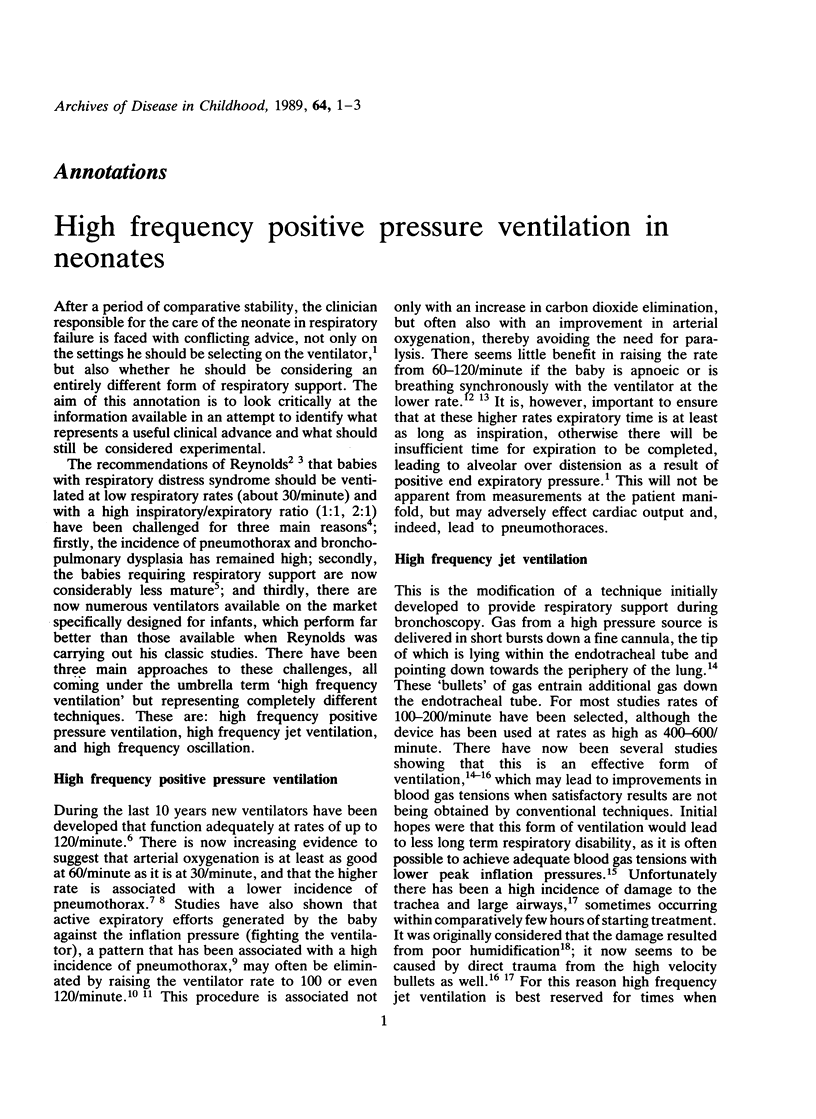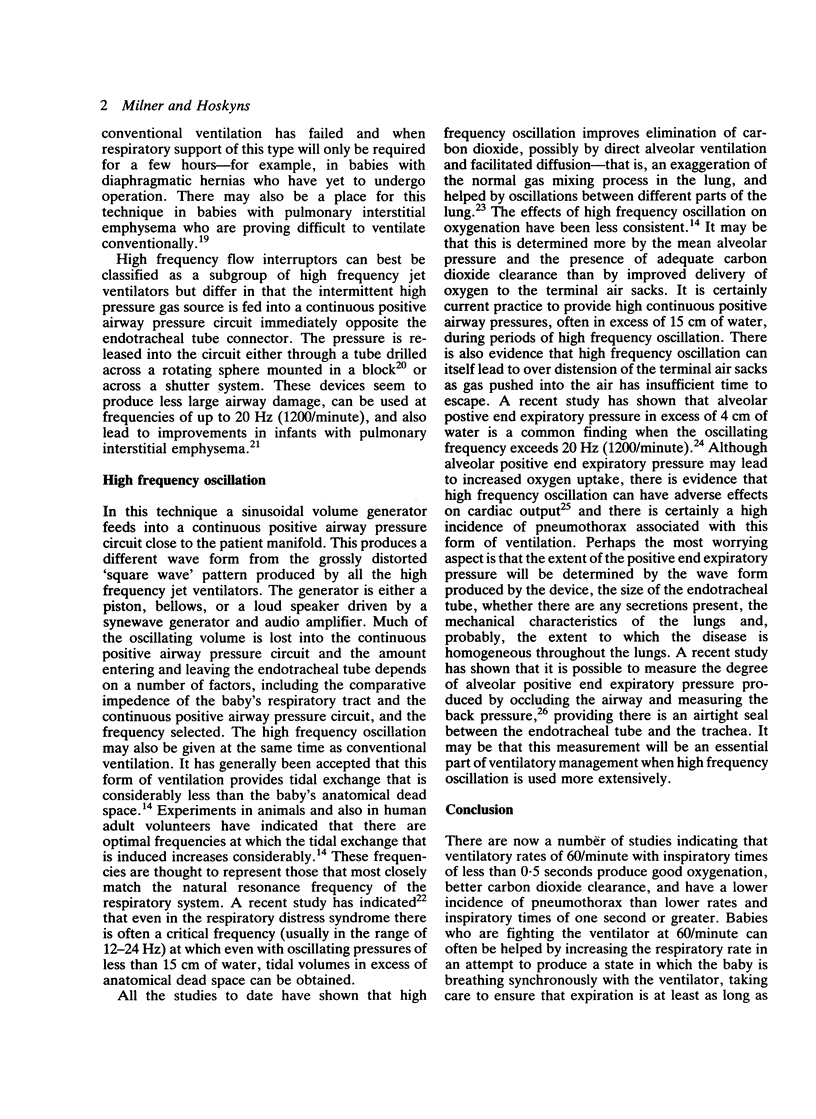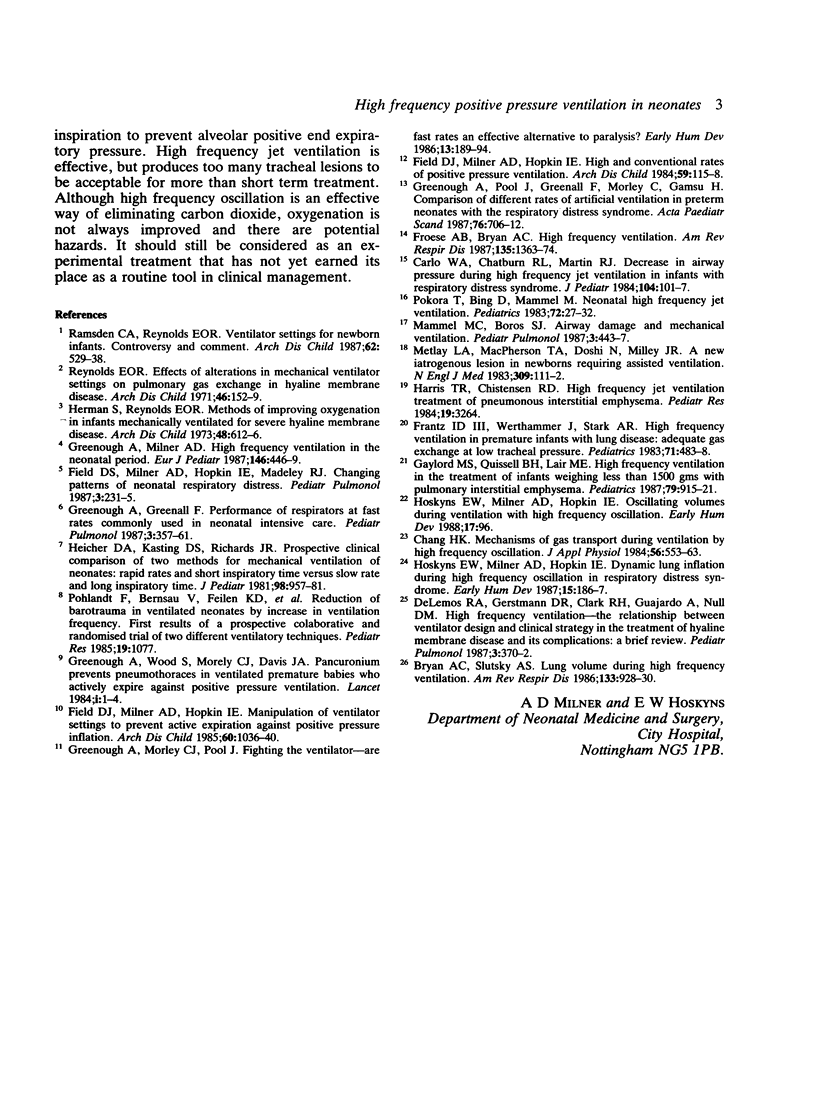Full text
PDF


Selected References
These references are in PubMed. This may not be the complete list of references from this article.
- Bryan A. C., Slutsky A. S. Long volume during high frequency oscillation. Am Rev Respir Dis. 1986 May;133(5):928–930. [PubMed] [Google Scholar]
- Buckler J. M. Skeletal age changes in puberty. Arch Dis Child. 1984 Feb;59(2):115–119. doi: 10.1136/adc.59.2.115. [DOI] [PMC free article] [PubMed] [Google Scholar]
- Carlo W. A., Chatburn R. L., Martin R. J., Lough M. D., Shivpuri C. R., Anderson J. V., Fanaroff A. A. Decrease in airway pressure during high-frequency jet ventilation in infants with respiratory distress syndrome. J Pediatr. 1984 Jan;104(1):101–107. doi: 10.1016/s0022-3476(84)80604-6. [DOI] [PubMed] [Google Scholar]
- Chang H. K. Mechanisms of gas transport during ventilation by high-frequency oscillation. J Appl Physiol Respir Environ Exerc Physiol. 1984 Mar;56(3):553–563. doi: 10.1152/jappl.1984.56.3.553. [DOI] [PubMed] [Google Scholar]
- Field D. J., Milner A. D., Hopkin I. E., Madeley R. J. Changing patterns in neonatal respiratory diseases. Pediatr Pulmonol. 1987 Jul-Aug;3(4):231–235. doi: 10.1002/ppul.1950030407. [DOI] [PubMed] [Google Scholar]
- Field D., Milner A. D., Hopkin I. E. Manipulation of ventilator settings to prevent active expiration against positive pressure inflation. Arch Dis Child. 1985 Nov;60(11):1036–1040. doi: 10.1136/adc.60.11.1036. [DOI] [PMC free article] [PubMed] [Google Scholar]
- Frantz I. D., 3rd, Werthammer J., Stark A. R. High-frequency ventilation in premature infants with lung disease: adequate gas exchange at low tracheal pressure. Pediatrics. 1983 Apr;71(4):483–488. [PubMed] [Google Scholar]
- Froese A. B., Bryan A. C. High frequency ventilation. Am Rev Respir Dis. 1987 Jun;135(6):1363–1374. doi: 10.1164/arrd.1987.135.6.1363. [DOI] [PubMed] [Google Scholar]
- Gaylord M. S., Quissell B. J., Lair M. E. High-frequency ventilation in the treatment of infants weighing less than 1,500 grams with pulmonary interstitial emphysema: a pilot study. Pediatrics. 1987 Jun;79(6):915–921. [PubMed] [Google Scholar]
- Greenough A., Greenall F. Performance of respirators at fast rates commonly used in neonatal intensive care units. Pediatr Pulmonol. 1987 Sep-Oct;3(5):357–361. doi: 10.1002/ppul.1950030512. [DOI] [PubMed] [Google Scholar]
- Greenough A., Morley C. J., Pool J. Fighting the ventilator--are fast rates an effective alternative to paralysis? Early Hum Dev. 1986 Apr;13(2):189–194. doi: 10.1016/0378-3782(86)90007-1. [DOI] [PubMed] [Google Scholar]
- Greenough A., Pool J., Greenall F., Morley C., Gamsu H. Comparison of different rates of artificial ventilation in preterm neonates with respiratory distress syndrome. Acta Paediatr Scand. 1987 Sep;76(5):706–712. doi: 10.1111/j.1651-2227.1987.tb10553.x. [DOI] [PubMed] [Google Scholar]
- Greenough A., Wood S., Morley C. J., Davis J. A. Pancuronium prevents pneumothoraces in ventilated premature babies who actively expire against positive pressure inflation. Lancet. 1984 Jan 7;1(8367):1–3. doi: 10.1016/s0140-6736(84)90177-6. [DOI] [PubMed] [Google Scholar]
- Heicher D. A., Kasting D. S., Harrod J. R. Prospective clinical comparison of two methods for mechanical ventilation of neonates: rapid rate and short inspiratory time versus slow rate and long inspiratory time. J Pediatr. 1981 Jun;98(6):957–961. doi: 10.1016/s0022-3476(81)80604-x. [DOI] [PubMed] [Google Scholar]
- Heij H. A., Bos A. P., Hazebroek F. W. "Acquired" congenital diaphragmatic hernia. Eur J Pediatr. 1987 Jul;146(4):440–441. doi: 10.1007/BF00444961. [DOI] [PubMed] [Google Scholar]
- Herman S., Reynolds E. O. Methods for improving oxygenation in infants mechanically ventilated for severe hyaline membrane disease. Arch Dis Child. 1973 Aug;48(8):612–617. doi: 10.1136/adc.48.8.612. [DOI] [PMC free article] [PubMed] [Google Scholar]
- Mammel M. C., Boros S. J. Airway damage and mechanical ventilation: a review and commentary. Pediatr Pulmonol. 1987 Nov-Dec;3(6):443–447. doi: 10.1002/ppul.1950030613. [DOI] [PubMed] [Google Scholar]
- Metlay L. A., MacPherson T. A., Doshi N., Milley J. R. A new iatrogenous lesion in newborns requiring assisted ventilation. N Engl J Med. 1983 Jul 14;309(2):111–112. doi: 10.1056/NEJM198307143090214. [DOI] [PubMed] [Google Scholar]
- Pokora T., Bing D., Mammel M., Boros S. Neonatal high-frequency jet ventilation. Pediatrics. 1983 Jul;72(1):27–32. [PubMed] [Google Scholar]
- Ramsden C. A., Reynolds E. O. Ventilator settings for newborn infants. Arch Dis Child. 1987 May;62(5):529–538. doi: 10.1136/adc.62.5.529. [DOI] [PMC free article] [PubMed] [Google Scholar]
- Reynolds E. O. Effect of alterations in mechanical ventilator settings on pulmonary gas exchange in hyaline membrane disease. Arch Dis Child. 1971 Apr;46(246):152–159. doi: 10.1136/adc.46.246.152. [DOI] [PMC free article] [PubMed] [Google Scholar]
- deLemos R. A., Gerstmann D. R., Clark R. H., Guajardo A., Null D. M., Jr High frequency ventilation--the relationship between ventilator design and clinical strategy in the treatment of hyaline membrane disease and its complications: a brief review. Pediatr Pulmonol. 1987 Sep-Oct;3(5):370–372. [PubMed] [Google Scholar]


